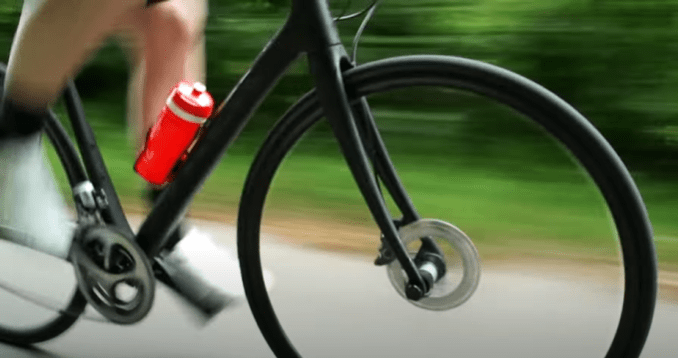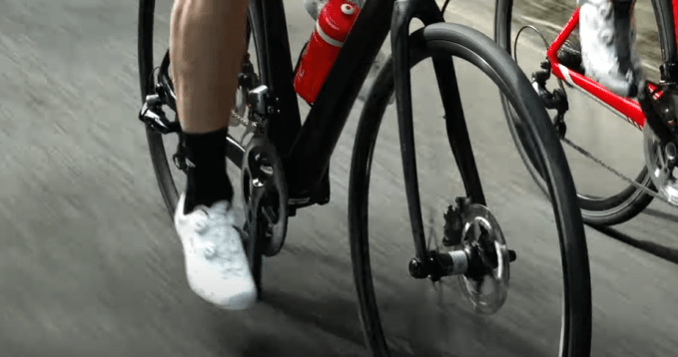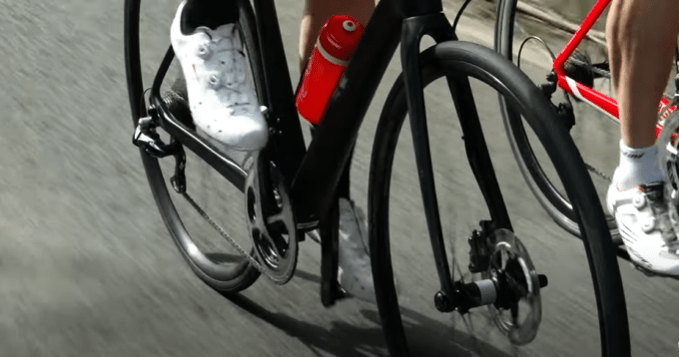

Disc brakes for road bikes have become increasingly available in bike shops over the past few years. The use of disc brakes in cycling technology has been a topic of much discussion.
While some praise the advantages of disc brakes, others reject the idea. Despite this, equipment manufacturers are still developing new solutions, but are not completely abandoning traditional brakes.
Although initially popular in mountain biking, disc brakes have gained support from a majority of new road cyclists.
So, are disc brakes a revolution or just a marketing tool? In this article, I will provide an objective overview of the key points of using disc brakes on a road bike.


Disc brakes have become a recent addition to the road bike market as bicycle brands are always looking for new technologies. However, the disc brake system is not a new invention. Let’s dive into its history!
The evolution of bike braking dates back to the 1800s when balance bikes were used. Backpedaling and jaw brakes made cycling easier in the following years. The disc brake system was invented after the introduction of mountain biking in the 1970s, where pad braking had its limits during competitions. Manufacturers then thought of a more efficient method to stop bikes on any terrain.
The disc brake system was first adopted in the 80s and was initially used in cars and motorcycles. However, when it was introduced to road bikes, it raised questions and was controversial, especially among professionals. The UCI banned the use of disc brakes in competitions in the early years. It was only in 2018 that they allowed the use of disc brakes after three years of testing.
Professional cyclists have gradually adopted the use of disc brakes, and the FFC validated them for the 2019 season. It is understandable that the amateur cycling world may have reservations about disc brakes due to a lack of perspective.


Disc brakes operate using both mechanical and hydraulic systems that activate the pistons.
When you pull the lever, the pistons in the caliper move and press the brake pads against the metal disc that is attached to the hub. This method is an alternative to braking with rubber pads, which can lose their effectiveness on carbon or aluminum rims.
There are three main activation devices for the braking system:
This system uses pistons that are actuated by conventional brake cables and levers. It is an entry-level model, but technicians find it less effective because stretched cables are easily damaged, requiring regular lubrication of the sheaths and cables.
This is the most commonly used technology in the industry. A hydraulic hose filled with oil activates the caliper pistons. The pressure of the oil in the ducts causes the braking on the pistons when the levers are requested. The circuit is closed, protecting it from humidity, mud, or other dust.
This is a mechanical-hydraulic hybrid principle where brake cables actuate the hydraulic caliper. This method allows you to benefit from the braking power of a conventional system, but it is rarely used in traditional bicycle brakes.


Installing disc brakes on your bike is a sophisticated process that requires specific modifications, which can be expensive and restrictive. However, there is a radical solution, which involves changing the entire bicycle.
Adapting your bike for disc brakes involves modifying elements on the frame, fork, wheels, brakes, and levers. The process requires a change of hubs and the placement of transmission controls with appropriate levers and brake calipers. You also need a frame kit with brackets on the fork and rear shrouds. The wheels must have compatible hubs that allow the discs to be attached.
There are three main techniques for fixing the disc on the hub of the wheel:
You can use several technologies to fix the caliper on your bike:
You can switch from one standard to another without difficulty. Adapters can also be fitted between the frame or the fork and the caliper, which facilitates the installation of the latter depending on the type of attachment or the size of the disc.


These elements ensure the power and safety of the braking system without weighing down the bike. There are two subjects to choose from:
Specialists generally recommend adopting a material measuring 160mm at the front and 140mm at the rear to define the diameter of the brake system disc. However, if you have a heavier template, you can opt for 160mm on both configurations. If you have a featherweight bike, go for 140mm on both.
The larger the disc, the more effective the braking will be. Ventilation of the brake discs also reduces the temperature and conserves the braking power. Shimano has developed Ice-Tech Freeza technology to lower the heat of the disc in intensive use.
Disc brakes used in road bikes consist of two parts: the lining in contact with the disc and the wafer support. The component of the lining must be of high quality to provide safe braking. There are several coatings available, including organic, metallic, semi-metallic, and ceramics.
The carrier materials help reduce the temperature of the disc brakes. They are made of either steel or aluminum, with the latter being more efficient in terms of heat dissipation.


When it comes to road disc brakes, several top brands dominate the market. Here’s a rundown of some of the leading names in disc brakes:
Shimano is known as the flagship brand for disc brakes. Although Shimano is well-known for “forcing the disc,” entry-level groupsets are still available in both rim and disc versions. Within Shimano’s range, the Dura-Ace hydraulic disc brake systems are very powerful, as are the Ultegra, 105, and Tiagra models. Both Dura-Ace and Ultegra disc brakes incorporate the oil reservoir in the handle. Additionally, Shimano has developed Free Stroke technology, which is already used in their MTB disc brakes. For triathlons and time trials, the Dura-Ace R9180 shifters are a more suitable option.
Since 2017, the Italian manufacturer Campagnolo has been present in the road disc brake market. The brand distributes groups classified at the top of the range, including Super Record, Record, and Chorus. Intermediate level groups include Potenza and Centaur. In terms of disc brakes, Campagnolo has developed H11 DB and Potenza DB sets, utilizing Disc Brake technology to reduce weight gain. Among the unique features of Campagnolo’s equipment is the magnetic configuration, which allows for the return of pads after braking or the wear indicator thereof.
SRAM’s disc braking equipment for road bikes has been designed around several groups, including Rival, Classical Force and AXS, and Classic Red + AXS. Users appreciate the aerodynamic design and brake modulation of the SRAM Red range.
Spanish equipment manufacturer Rotor has partnered with Magura, a leading disc brake manufacturer for mountain bikes, to offer hydraulic systems. Products sold include the Uno group, covering both the pads and the discs. Magura MT8 disc brakes are easy to adjust and allow for quick wheel changes.


When considering disc brakes for road bikes, it’s important to take into account the cost of the various components including levers, rotors, and calipers. Here’s a breakdown of average prices for some popular brands:
It’s important to keep in mind that the cost of disc brake groups can vary based on factors such as the level of technology, materials used, and brand reputation. It’s worth considering your specific needs and budget before making a decision.


The brands compete in imagination to improve the feelings of cyclists on road bikes. But, in reality, it must be recognized that adopting disc brakes on your cycle has both advantages and disadvantages. OK, I’m not helping you on this one!
Cycling brands constantly strive to enhance the riding experience of road cyclists. However, it is important to acknowledge that adopting disc brakes for your cycle has its own set of advantages and disadvantages. Let’s explore the benefits of road bike disc brakes:
Despite the advantages, road disc brakes also have some drawbacks:
In conclusion, the balance for road bike disc brakes is evenly weighed. Although sales are increasing, brake pads still dominate the market share. Ultimately, it is up to the individual cyclist to decide if the advantages outweigh the disadvantages and if the purchase is justified based on their needs and type of practice.
